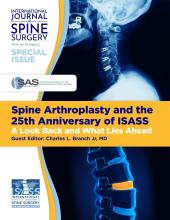ABSTRACT
Background Complications occurring after spinal procedures are associated with recurrent symptomatology, new-onset symptomatology, and increased health care costs. The American Society of Anesthesiologists (ASA) score is a commonly cited risk factor for complication incidence. Few investigations have been performed analyzing the relationship between ASA score and complication rate following spinal minimally invasive surgery (MIS) decompressions or fusions. Therefore, the purpose of this study is to determine whether an association exists between preoperative ASA score and the incidence of postoperative complications among patients undergoing MIS posterior lumbar decompression or fusion.
Methods A surgical registry of patients undergoing single-level MIS posterior lumbar decompressions or fusions between 2007 and 2016 was retrospectively reviewed. Patients were stratified by preoperative ASA score (≤2, >2). The ASA score was tested for an association with preoperative demographic, comorbidity, and perioperative characteristics using the Student t test or χ2 analysis. Multivariate Poisson regression with robust error variance was used to test for an association between ASA score and the incidence of complications up to 6 months postoperatively.
Results A total of 772 patients were analyzed. Of those, 86.7% had an ASA score ≤2, whereas 13.3% had an ASA score >2. An ASA score >2 was associated with older age (P < .001), higher comorbidity burden (P < .001), and higher rates of obesity (P < .001). An ASA score >2 was also associated with significantly longer operative time (P = .001) and longer length of hospital stay (P < .001). Upon multivariate analysis, ASA score category was not associated with the incidence of any complication (P = .248), medical complications (P = .227), or surgical complications (P = .816).
Conclusions The ASA score was not a predictive factor for complication incidence up to 6 months postoperatively. Thus, a higher ASA score should not preclude patients from being surgical candidates for MIS posterior lumbar decompressions or fusions. Further investigation is required to identify other predictive factors for complication incidence after minimally invasive spine surgery.
Level of Evidence 3
- minimally invasive spine surgery
- transforaminal lumbar interbody fusion
- lumbar decompression
- medical complications
- surgical complications
- American Society of Anesthesiologists score
- risk factors
Footnotes
Disclosures and COI: No funds were received in support of this work. No benefits in any form have been or will be received from any commercial party related directly or indirectly to the subject of this manuscript.
- ©International Society for the Advancement of Spine Surgery







